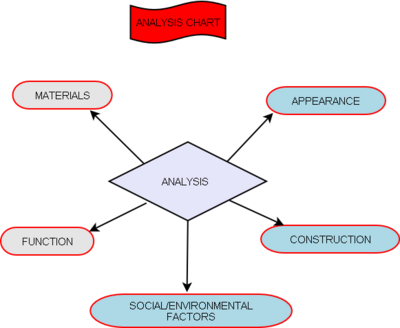Lesson1 2: Analysing Design Problems
Contents
Introduction
You have been able to identify various problems under variety of contexts in Lesson one. In Design and Graphic Communication, you have to research into the problem at stake in detail before going ahead to manufacture. The best method for investigating is to pose series of questions to serve either as checklist or guidelines for your investigation. This technique is termed 'Analysis'.
By the end of the lesson, learners will be able to:
|
Ways of analysing
Having framed your situation and brief, you have to consider five main elements required to make the project come into existence. You will have to brainstorm through a flowchart or spider web diagram. Take the five elements one after the other and pose series of questions to guide you as explained earlier on. You have to present a neat diagram such as a bubble chart or web diagram to facilitate the framing of the questions. This also ensures that all vital areas have been covered. Figure 2 shows a bubble chart of analysis.
On materials for instance, you should research into the most appropriate material. For instance, should it be plastic, wood, metal ceramic etc.? You could also research into the availability or other substitutes in case of non-availability. You could also research into the aesthetic qualities of the material and its toxicity. In case you have to design and make a toy for a child below three years, note that that child is likely to keep the toy in its mouth. Hence it is appropriate that the toxicity of that material is researched into. You should also consider the physical property of the material. For istance its weight, hardness, density, durability and conductivity. Physical properties and Aesthetic qualities of materials could be brainstormed separately. In view of this, some questions you could pose for materials to be used are:
Material
- What materials will be most suitable?
- Which material is available?
- What physical properties should the material possess?
- Should the material be durable?
- Is colour an important feature for the project?
Physical properties
Aesthetic qualities
Under construction, you will think of the most appropriate joints to cut or use. For instance, if you are using a plastic material, you will have to research into fasteners such as adhesives. You will also have to consider how you will cut and shape. Consider researching into the cost of construction. Do you have the requisite skills to carry on unaided? If you need helping hands or assistance, research into the number of hands needed and the cost of labour. Think also of how you will assemble and finish your object. With regard to these, some of the questions you could ask are:
Construction
- What tools and equipment would be needed?
- Would the construction require any special skill?
- Would the object need attachment like stands and handles?
- If yes, how would they be attached?
- What shape would these attachment be?
With functions, you've got to think of the main purpose of the item to be designed and made. Research to consider a secondary function. Apart fron its purpose, you could also research into the mode of functioning of the item. for instance, its mode of operation. Would it be best to be operated mechanically, electronically, electrically, by hydrolysis etc.? In view of these, some of the questions you could ask are:
Functions
- What would be the main function of the object?
- What will be the size of the object?
- How heavy should it be?
- What would be the mode of operation? Mechanical? Electrical?
- How will the object be supported?
Another element worth researching into is how you want the item or object to be disigned to look like. the beauty of a product quite often depends on its appearance. Over here, you will have to research into the shape, size, colour, surface texture of the finished product, stability of the joints, height and many others.Other sub-headings for appearance could be Aesthetic Qualities, Ergonomics and Safety. You may take these sub-headings as separate entities and pose questions under them. some of the questions you could therefore ask are:
Appearance
- What shape/form should the object take?
- Is surface texture an important aspect of the object?
- Is colour a vital issue to be considered?
- If colour is important, what should be the most appropriate colour?
- How can you make the object safe to use?
Aesthetic qualities
Ergonomical factors
Safety Aspect
Another element usually overlooked is the eco-system. You have to consider the effect of your production on the people and the environment. think of the waste disposal techniques. Research to find out if the waste produced could be used. Hence some of the questions you may ask include: inhabitants anderation given to the eco-system
Social/Environmental Factors
- Will the manufacture of the product have a detrimental effect on the people and environment?
- What effect would the waste produced have on the people and environment?
- Would the waste be used as fuel or recycled?
- If the waste would be used as fuel, will it be safe and economical to use?
- Will the product be safe to use?
| In this lesson, you have learnt about ways and means of framing questions to serve as guidelines for your research work. You have also been introduced to the five main elements to be considered in order to design and make an object. You have also been guided through the main issues to be considered under the various elements when analysing. Quite a number of examples of questions have been posed under the five main elements for youi. Remember that the list is always not exhaustive. You should always add to them. |
